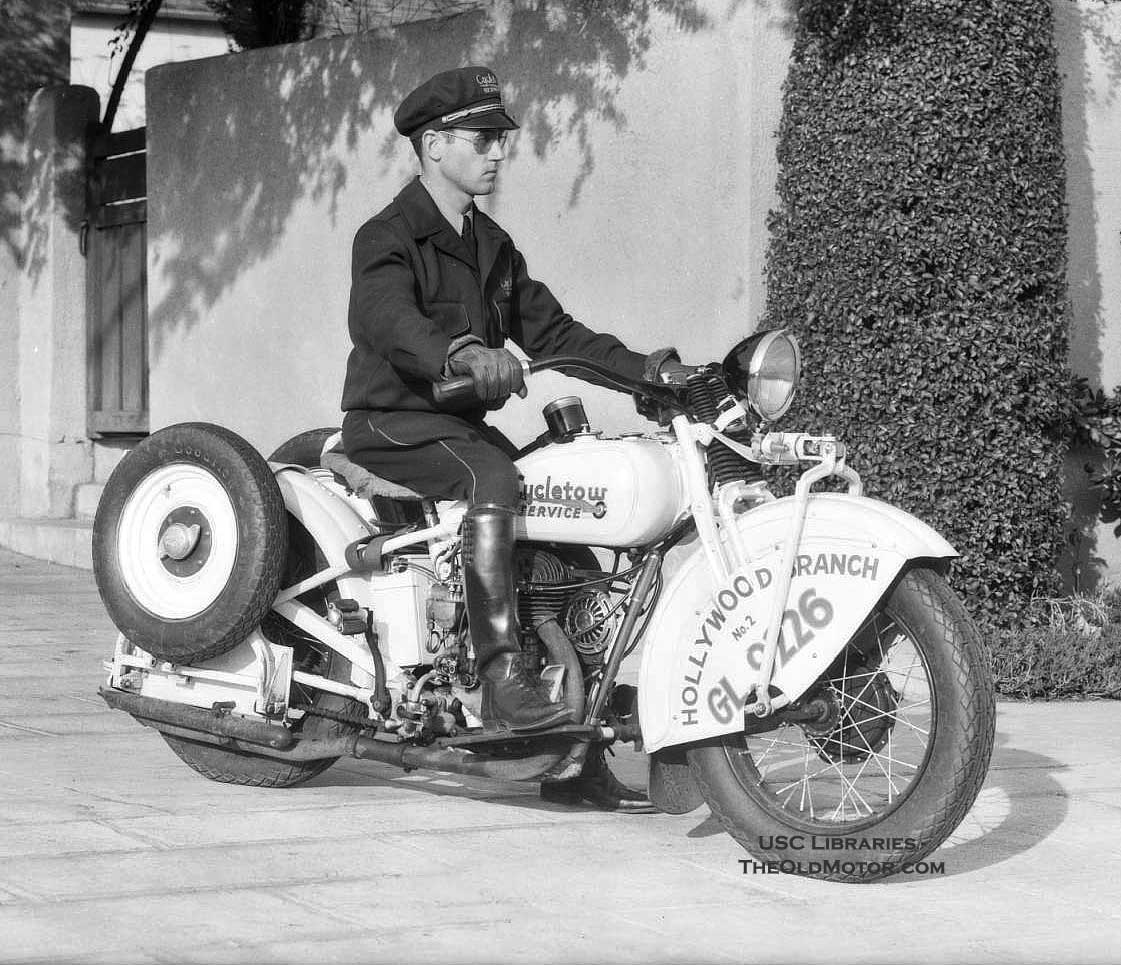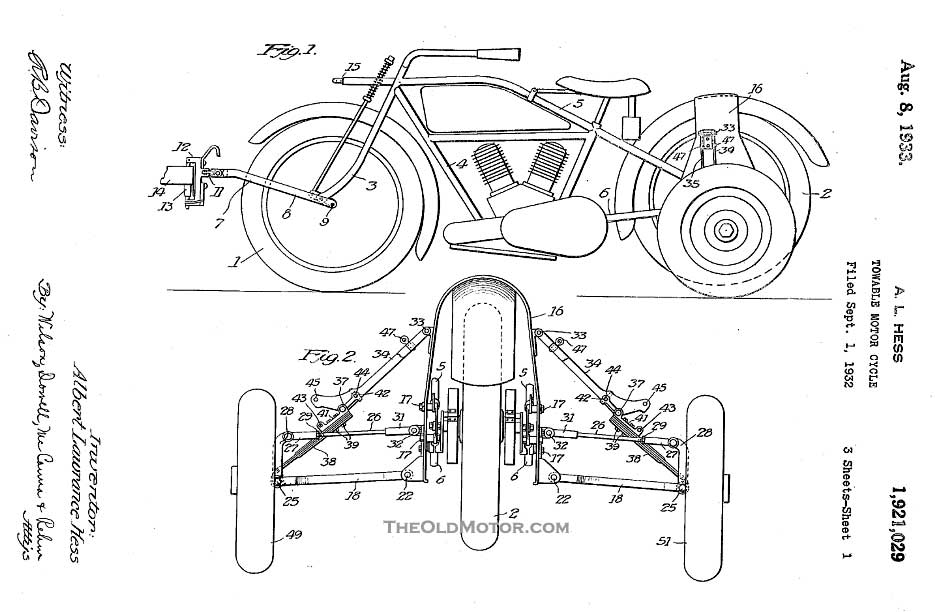Thank you for posting this thread and the pictures. As we've oft said: "Nothing new, under the sun." As people of my generation (the "baby boomers") age out and want to keep riding motorcycles, the idea of the "articulated training wheels" has re-surfaced. I've seen a few motorcycles outfitted with aftermarket "training wheels", and spoken to one rider who had reached the point where he could not rely on his legs to hold the bike up at stoplights and in parking situations. These "training wheel" setups use automotive wheels, and shock absorbers, along with a linkage that allows the bike to lean when taking curves. Basically the same concept as the Cycle Tow.
When I was a kid, in the 1950's, in Brooklyn, NY, H-D three-wheelers were all over the place. The three-wheelers were in use by various local businesses for delivery purposes. All of them had a kind of "box body" in which merchandise or tools could be hauled. There were several "ignition shops" (shops which rebuilt distributors) and "automotive electric shops" (shops rebuilding generators and starters), and "carburetor shops" along with a big distributor of auto parts. These shops used three wheelers (H-D's I think) to make deliveries and pickups. A garage might need a generator or starter for a customer's car, so would call it in. A man on a three-wheeler made the rounds, handling core-exchanges on rebuilt units, and picking up or dropping off specialized parts where there was no core exchange. Coca-Cola bottling had a few of the three wheelers running around as well, as did one local pharmacy.
A local repair garage did have a three wheeler which they sent out on road service calls. Mostly, this was to bring a booster battery and jump start customers' cars, bring a can of gasoline, or do minor curbside repairs. By that point in time, nearly all the repair garages and gas stations had picked up WWII surplus Jeeps as their service vehicles. The Jeeps had home-made "push plates" on the front, with pieces of old tires as "softeners". In the 50's most of the cars still had manual transmissions, so a push start for a car with a weak battery or bad starting motor was often the way to get a customer's car going. Couldn't do that with a 3 wheel cycle. The Jeeps sported home-made plywood cabs (winters in Brooklyn and being parked on the streets took a toll on the the GI issue rag tops). A slushy day in Brooklyn was not a good time to be out and about on a 3 wheel cycle. Most of the Jeeps also had some kind of snow plow hoist, and did additional duty pushing snow off the station lots. The gas station owners and their mechanics were resourceful. A Jeep could do a lot more than a three-wheel cycle, so it was a no brainer, and the 3 wheelers vanished quickly.
I took the three wheelers for granted, then they were gone before anyone realized it. The last serious application of three wheeled cycles was for parking meter patrols in various cities. I think H-D offered their three-wheelers for police work into the early 60's, and that was the end of the line. Cushman offered a three-wheeler in competition with the 3 wheeled cycles. The downside of the three wheeled cycles was they were not the most stable or roadworthy thing around. Kind of a fooler, since many people- seeing three wheels instead of two- think a motorcycle is less stable and has the poorer road handling. Oldtimers who drove the three wheelers in service for businesses have told me the three wheelers were mainly a low-speed vehicle. Get them on a back road and take a curve with any kind of speed, and they were apt to lift a rear wheel or roll. The last three wheeler I saw in actual work was in Utica, NY in about 1985, on parking meter patrol. There was no mistaking it as a 3 wheeled cycle- not a three wheeled Cushman. Cushman, having smaller wheels and a lower center of gravity and a "step thru" type of frame was a more user friendly proposition. Vespa and Lambretta- the Italian motor scooter builders- also offered three wheelers. These all were built as serious working vehicles. My belief is the three wheeled scooters hung on longer, mostly for work like ice cream vendors or as a novelty used by some businesses.
At the Antique Motorcycle Club meet in Rhinebeck, NY, there are always a few of the three wheeled service vehicles. These are restored and have the "flip up" tow bars. It was a different era when a garage would send a man out in a uniform including a necktie, to go bring in a customer's car. Of course, back then, cars COULD be towed without a second thought. No front wheel drive transaxle or automatic tranny to worry about. No chintzy plastic air dams and energy absorbing plastic shelled bumpers. Plenty of structural steel to clamp a tow bar to and drag a car off of. Today's answer is the tilt bed truck. Send out one man with a tilt bed, as it is about all that can handle today's cars. Instead of a uniformed mechanic on a spit shined service cycle, you get a tilt bed, generally with chrome wheel centers and plenty of wild paint work, and a driver who may be in a tee shirt. Instead of a driver with an order pad and carbon paper, you get a driver with a computer in the cab and equipment to take your credit card. Of course, cars have changed drastically. In the days of the Cycle Tow or the Servi-Cars or Service Cycles, a mechanic COULD do a LOT of repairs on the scene to get a customer's car going. File and re-gap a set of points, put in a set of points, change spark plugs (if a customer did not work the choke properly and fouled out the plugs), start a car that a customer had "flooded the engine" on, tighten or replace a fan belt, dress contact points in the voltage regulator and flash the field, put a new diaphragm in a fuel pump, clean out the carburetor sediment bowl and clean the jets...... Basically, in those days, short of something major breaking in the engine or driveline, a mechanic could do a lot of roadside repairs and get a customer's car going again. With today's cars, the odds of fixing much of anything by the roadside are almost nil. The odds of a mechanic being able to troubleshoot using his ears, eyes, fingertips and instincts are also almost nil. Now, it is a case of flatbed the car into the shop, plug it into the computer, get the codes and follow a "fault tree" as to what parts to change out. It's like Star Wars when compared to the days of the Cycle Tow and the mechanics who went with it.
In another thread, I recalled the old chain drive AC series Mack Trucks on the streets when I was a kid. Seeing and recollecting about it makes me realize how far things have come in my own life. We had fruit and vegetable peddlers with horse-drawn wagons, we had horse-drawn junk wagons, and Divco milk delivery trucks all on the streets when I was a kid, along with the old chain drive Macks and the three-wheeled cycles. No novelty to any of it, we took it for granted. In fact, we took it so much for granted most of us did not realize any of it was gone until those vehicles started turning up at antique and vintage shows. I won;t say I feel old, 'cause I don't. I still ride the same 1978 BMW R 100/7 motorcycle I bought new. It still has the original ignition system- coil and points, and it still has the original carburetors. It has solid valve lifters, so I check and adjust the valve lash. It has the "laced" wire spoke wheels, like the Cycle Tow in the picture. I "ping" or "sound" the spokes to check their tension when I maintain the bike. It has Timken roller bearings in the wheels and swingarm pivots- another vanishing thing. New motorcycles use sealed ball barings in the wheels (maybe it is cost effective, maybe they figure to eliminate a potential liability by eliminating the need for mechanics/owners to set the preloads or repack bearings ?), and they use plastic bushings in the swingarm pivots. It's a combination of a "throw away" design and a combination of making things so no mechanic's skill or instincts are needed.
I enjoy having a machine I know intimately and can work on. It has taken me through my life, and I've had it longer than I've been married (32 years) and longer than I worked for the Power Authority (retired from them after 32 years). My wife calls it our "heirloom bike" that will pass to our son. It's not a creampuff or show bike, but a daily rider and workhorse. Back in the days of the Cycle Tow and the Service Cycle or Servi-Car, the motorcycle was still regarded as a working vehicle and not a weekend toy to be ridden only in fair weather on hard paved roads. Being a mechanic was an honorable calling, and it all fit together with the times. As much as we've gained and progressed over the years since the days of the Cycle Tow, we've lost or "watered down" quite a bit in our society. Seeing the way the mechanic on the Cycle Tow was dressed kind of hammers it all home. Thanks again for posting.




